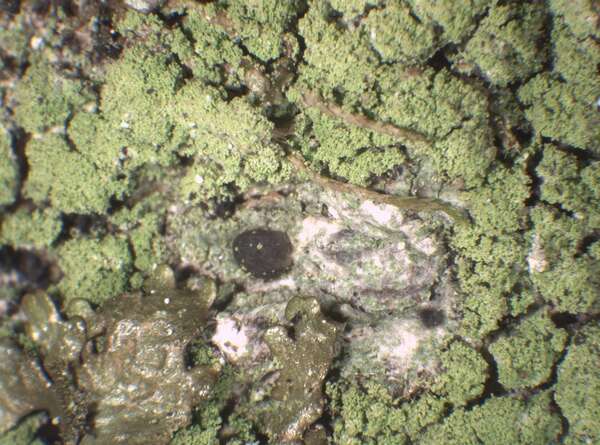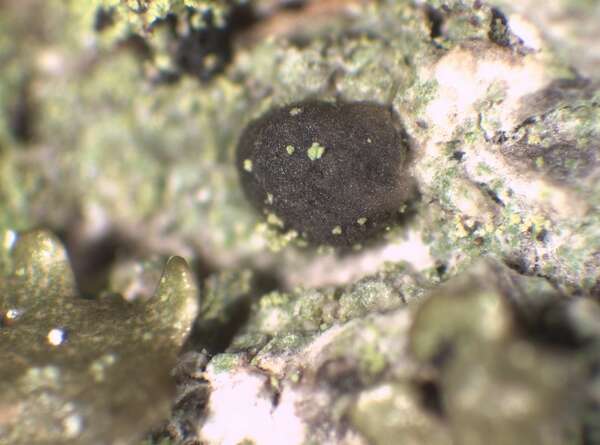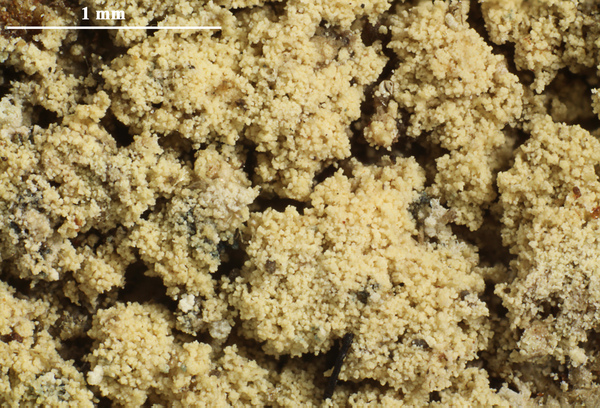Biatora pontica Printzen & Tønsberg
Bibl. Lichenol., 86: 40, 2003.
Synonyms:
Distribution: N - Frl (Printzen & Tønsberg 2003, Tretiach 2004). C - Abr (Di Santo & Ravera 2012, Corona & al. 2016).
Description: Thallus crustose, episubstratic, at first thin and areolate, the areoles (in non-sorediate parts) up to 1.2 mm wide, with initially punctiform, then confluent, yellowish- or green soralia which in mature specimens may cover almost the whole thallus surface, giving it a subleprose appearance; soredia farinose, 15-35 µm. Apothecia biatorine, 0.5-0.7 mm across, with a flat to moderately convex, dark greyish-ochre to brownish-grey disc and a soon excluded proper margin. Proper exciple colourless distally, rarely pale ochre or olive proximally, 30-60 μm wide laterally, 10-60(-85) μm wide at base, of radiating hyphae; epithecium colourless or pale ochre to olive, 5-10 μm high; hymenium (30-)40-50 μm high, colourless to patchily pale olive, often with purple granules; paraphyses simple or sparingly branched, the apical cells rather swollen; subhymenium distinct, 40-75(-90) μm high; hypothecium colourless or pale ochre with patches of blue or purple pigment, 40-100 μm high. Asci 8-spored, clavate, with a K/I+ blue apical dome penetrated by a narrow, K/I– apical cushion surrounded by a narrow, deeply K/I+ blue zone, the wall K/I- but surrounded by an I+ red-brown, K/I+ blue outer layer, the ocular chamber relatively small, Biatora-type. Ascospores 0(-3)-septate, hyaline, narrowly ellipsoid to bacilliform, (7-)10-16(-23) × 2-4(-4.5) µm. Photobiont chlorococcoid. Spot tests: soralia K-, C+ orange KC+ orange, P-; subhymenium K+ intensely lemon yellow, turning ochraceous after some minutes, N+ greenish yellow. Chemistry: thiophanic acid (major), asemone, and an unidentified diagnostic substance (Pontica-unknown), sometimes with minor or trace amounts of other xanthones. Apothecia with a blue pigment (Pontica-blue) in hypothecium, subhymenium, and (rarely) hymenium and epithecium; sometimes an additional red pigment (Pontica-red) is present in the hypothecium and hymenium.Note: described from Turkey, and also known from Scandinavia, Austria, Slovenia and eastern North America, this species occurs on acid to subacid bark in shaded and humid situations within old montane forests, mainly on Fagus and Abies.
Growth form: Crustose
Substrata: bark
Photobiont: green algae other than Trentepohlia
Reproductive strategy: mainly asexual, by soredia, or soredia-like structures (e.g. blastidia)
Most common in areas with a humid-warm climate (e.g. most of Tyrrenian Italy)
Commonnes-rarity: (info)
Alpine belt: absent
Subalpine belt: absent
Oromediterranean belt: absent
Montane belt: very rare
Submediterranean belt: absent
Padanian area: absent
Humid submediterranean belt: absent
Humid mediterranean belt: absent
Dry mediterranean belt: absent

Predictive model
Herbarium samples


P.L. Nimis; Owner: Department of Life Sciences, University of Trieste
Herbarium: TSB (35440)
2002/12/03


P.L. Nimis; Owner: Department of Life Sciences, University of Trieste
Herbarium: TSB (35440)
2002/12/03
apothecium


P.L. Nimis; Owner: Department of Life Sciences, University of Trieste
Herbarium: TSB (35440)
2002/12/03
sterile thallus
Growth form: Crustose
Substrata: bark
Photobiont: green algae other than Trentepohlia
Reproductive strategy: mainly asexual, by soredia, or soredia-like structures (e.g. blastidia)
Most common in areas with a humid-warm climate (e.g. most of Tyrrenian Italy)
Commonnes-rarity: (info)
Alpine belt: absent
Subalpine belt: absent
Oromediterranean belt: absent
Montane belt: very rare
Submediterranean belt: absent
Padanian area: absent
Humid submediterranean belt: absent
Humid mediterranean belt: absent
Dry mediterranean belt: absent

Predictive model
| Herbarium samples |


P.L. Nimis; Owner: Department of Life Sciences, University of Trieste
Herbarium: TSB (35440)
2002/12/03


P.L. Nimis; Owner: Department of Life Sciences, University of Trieste
Herbarium: TSB (35440)
2002/12/03
apothecium


 INDEX FUNGORUM
INDEX FUNGORUM
 GBIF
GBIF
 DOLICHENS
DOLICHENS



